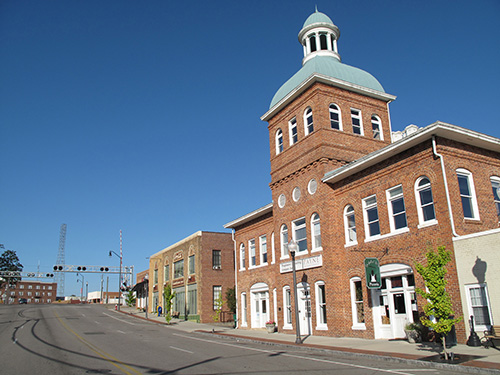City at World’s End
|
|
According to City-Data.com, Sanford is a town of roughly 30,000. It doesn’t feel that big, though. A 15-minute walk from city center to the James House; the grocery store another ten minutes beyond. Depot Park, La Dolce Vita Pizzeria, Cafe 121, the Antique Mall … all my usual haunts, all within a three-block radius.
And the theater, of course.
If I were a more convivial person, I’d be on a first-name basis with at least a half dozen proprietors by now. Waitresses say, “You don’t need a menu, do you, honey?” and I say no.
For a semi-citified small town boy like me, and taken in five-week chunks (the average length of a performance contract at Temple), Sanford is just what the doctor ordered. It’s wholesome. Root-conditioning. Calming. Tonic.
![]()
Edmond Hamilton’s novel City at Worlds End describes a town much like Sanford in size and appearance. Respectable people doing what needs to be done. Then disaster. A nuclear bomb is detonated nearby, punching a hole in the space-time continuum, and the entire town is sucked through that hole millions of years into the future.
Quite apart from the high strangeness of its premise, Hamilton’s book is remarkable to me mainly for how entrenched its characters are in their way of life. When they realize what’s happened, that a miracle has occurred in effect, nobody says anything at all akin to “Wow!” There’s plenty of fear and rage, but no awe. When they find a vast, abandoned but pristine city nearby, they enter it reluctantly. Worra, worra. When a spacecraft lands, they’re frightened, then suspicious, then angry again. Finally, when the leading man, a virile young scientist, gets to travel in that spacecraft to a distant star system, Hamilton narrates the scientist’s thoughts thusly: Carol was right, the old ways and the old things were best! What was he doing out here in these alien immensities?
World’s End was published in 1952, so historical context might explain its xenophobia and steadfast devotion to “the old ways.” We might allow that dogged parochialism is to be expected of — or at least forgiven in — characters for whom the Great Depression and the Second World War are recent, bitter memories.
We might.
Or we might not.
![]()
On a possibly related note ….
There’s a professor of religious studies at Rice University named Jeff Kripal. He’s associated with the the Esalen Center, a new age think tank in Big Sur, California. Kripal acknowledges the reality of the UFO phenomenon, but believes that it’s a “reflection or refraction” of something much more interesting than warp drives and transporter beams. He also talks about the effect of science on the “religious imagination” —how religions imagine the afterlife, for example. “Intellectual generosity” is a term he uses in this context … an openness to new ideas, even ideas that conflict with current beliefs. Similarly, UFO historian Richard Dolan predicts that we’ll reach a tipping point soon, triggering Steve Bassett’s much-heralded cultural paradigm shift and obviating the need for an official announcement by any government, including ours. Wishful thinking, perhaps, but it makes a kind of sense.
![]()
Acting on a friend’s suggestion, I took an Enneagram test yesterday (the $10 whole-hog version) to find out what kind of person I am. No, that’s not right. I took the test to see if it would confirm what I already believe myself to be. It did. I’m evenly distributed among the three personality sectors … a Reformer (score: 23), an Individualist (score: 23) and an Investigator (score: 22). Types 1, 4 and 5, respectively.
I’d have dismissed the test results if I hadn’t agreed with them, though, so how intellectually generous does that make me? Maybe I’m as attached to “the old ways and the old things” as Hamilton’s hero is.
![]()
Which brings me back to Sanford.
The old ways are well represented here. The leisurely self-assurance. The assumed familiarity. Traits both attractive and annoying.
Which brings me to back to my test scores.
The Enneagram Institute says that ambiguous test results like mine are evidence of either an unusually integrated personality or a not-unusually disintegrated one. I’m betting on the former, of course. Which might be evidence of the latter.
![]()
Speaking of disintegration, and my pretty firm belief that 9/11 was a self-inflicted wound, I leave you with a portrait of something transcendental that took place that day. Please watch the YouTube video embedded here. Be moved.
